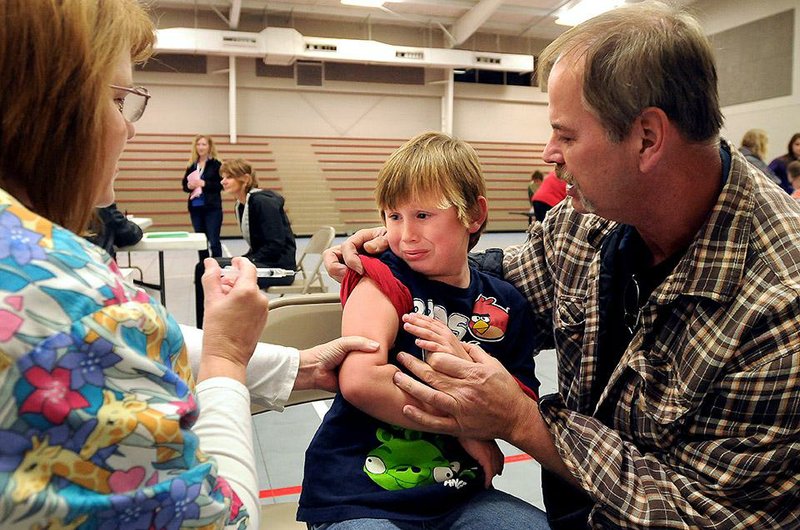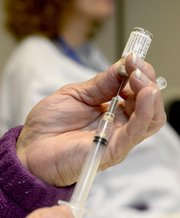The first flu deaths in the state were reported to the Arkansas Department of Health this week as flu activity surged higher than peaks in 2013 -- the deadliest flu season in Arkansas in more than 30 years.
Flu caused two deaths reported to the state Department of Health between Dec. 21 and Friday, according to a report released by the department Tuesday. One victim was between the ages of 25 and 44, and the other was older than 65.
The report also indicates that flu activity is currently high in the state. Flu activity is gauged by indicators such as hospital admissions, emergency room and outpatient visits, and positive flu test results.
There have been 451 hospital flu admissions in the state since the season began in September, according to the Department of Health. There were 264 hospital admissions by the end of December during the 2013-14 flu season.
More than 5,400 positive flu tests have been reported to the Department of Health since September, the report states. In comparison, a flu report released by the department Dec. 31, 2013, reported 1,500 positive flu cases.
There were 76 flu-related deaths in the state during the 2013-14 season.
"I think we are in for a very serious flu season," said Jennifer Dillaha, Health Department medical director for immunizations. "We haven't even peaked yet. I am concerned that we will have increased circulation once schools resume."
A flu season peaks when activity reaches the highest level of reported cases. Flu seasons typically peak in January in Arkansas, Dillaha said. It is impossible to determine the peak of the season until it is over.
About 16 percent of all emergency room visits in the state last week were for influenza-like illness, according to the report. The 2013-14 flu season in January saw 14 percent of total emergency room visits for the flu.
The term "flu-like illness" defines a population that has tested positive for respiratory illnesses. Hospitals and health care providers typically do not test every patient specifically for the flu but instead test a percentage of the population to verify what illnesses are circulating.
Another 10 percent of all outpatient visits in the state were for influenza-like-illness last week, according to the report. Outpatient visits for flu symptoms topped 8 percent during the 2013-14 flu season.
It is impossible to tell what age groups the flu is affecting most at the state level, Dillaha said. She said not every health care provider reports flu data to the Health Department.
"We are aware of influenza occurring in nursing homes this year," Dillaha said. "We also are aware of an increased number of children being seen. There are a lot of people who don't get the test so we don't have a good way of gauging where the flu is around the state."
Robert Steele, Arkansas Children's Hospital senior vice president and chief strategy officer, said the hospital is seeing an increased number of flu cases, including severe cases.
About 50 percent of children visiting the hospital's emergency room have flu-like illnesses, Steele said. He said about 38 percent of patients visiting the emergency room during the 2013-14 flu season had flu-like illnesses at the peak of the epidemic.
"We have had a significant increase in respiratory illness in general," Steele said. "Much of it is the flu."
Out of 140 patients with flu-like illnesses that visited the emergency room Monday, 27 of them -- or 19 percent -- had illnesses severe enough to be admitted to the hospital, Steele said. He said it is typical to see 10 percent to 15 percent of the patients admitted.
"That doesn't sound like a big jump but it is," Steele said. "That is pretty substantial."
Eight of the patients are being treated in the intensive care unit, Steele said.
"There are plenty of children who will get influenza and do fine, in fact, the majority will," Steele said. "However, the strain we are seeing tends to cause a lot of inflammation in the lungs. When that happens it sets you up for pneumonia."
The Centers for Disease Control and Prevention has reported that H3N2 is the predominate strain circulating this flu season. It has historically caused twice as many deaths as other strains. The CDC also has reported that the strain can be more severe in children and the elderly.
A majority of the H3N2 strains have drifted or mutated and are not found in the vaccine distributed this year, CDC officials said. The CDC still encourages the public to get vaccinated to protect against other flu strains that also may be circulating. The vaccine may offer some protection against the mutated strain.
The CDC reported that the flu season reached epidemic status nationally this week with 6.8 percent of all deaths reported caused by pneumonia and influenza. The epidemic threshold is 6.8 percent for late December. The threshold changes depending on the time of year.
The CDC uses five years of historical data to create a seasonal baseline. The epidemic threshold increases and decreases with this baseline throughout the year.
Not all adult flu-related deaths are reported to the CDC. Instead, the CDC monitors flu activity through reports from 122 cities found in its Mortality Reporting System. However, children's flu deaths are reported. The CDC has reported 15 pediatric deaths nationally since September.
Robert Hopkins, professor of internal medicine and pediatrics at the University of Arkansas for Medical Sciences and director of the division of general internal medicine, said emergency room visits and admissions for adults at the UAMS Medical Center are about average for this time of the year.
There have been some hospital admissions and intensive care unit patients, Hopkins said.
"Those numbers are about average for late December," Hopkins said.
Metro on 01/01/2015


